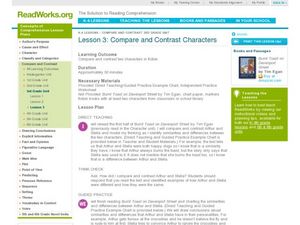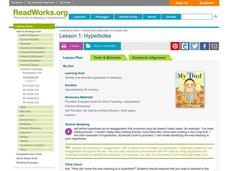Curated OER
Compare and Contrast Characters
Third graders compare and contrast. In this compare and contrast lesson students find similarities and differences between two characters from a fiction book. Students use a graphic organizer.
Curated OER
Identifying a Title for a Passage Based on the Main Idea
Third graders create a title. For this lesson students read a passage and discuss the main idea. Students determine the main idea for each paragraph of the passage. Students choose a main idea for the passage and use the main idea to...
Curated OER
Predicting a Solution to a Problem
Students explore story structure. In this story structure literacy lesson, students listen to the story Ruby's Wish by Shirin Yim Bridges, stopping at points to identify a problem and predict possible solutions which are then written on...
Curated OER
Third Person Point of View
Have your class practice determining whose point of view is being utilized throughout the course of a story. They begin by working as a class to create a chart which will provide textual examples that describe first and third person...
Curated OER
Setting's Effect on a Character's Actions
Do the actions of a character in a story change based on the setting the writer provides? Learners explore the concept of character action in relation to story setting by investigating the setting and events in the story Science...
Read Works
Dictionary
Dictionary skills are important to learn. Model how to find a word in the dictionary and how to choose the correct definition. As a class, look up words from The Life Cyle of a Bettle. Additionally, encourage your class to determine...
Curated OER
Words and Phrases that Support the Author's Voice
Third graders examine the author's voice. In this author's voice lesson students read poems by Shel Silverstein. Students choose words and phrases that indicate the author's voice.
Curated OER
Comparing Author's Voice
Third graders compare various voices. In this author's voice lesson students read poems from two books, Spooky ABC and Where the Sidewalk Ends. Students choose words that indicate the voice of the author.
Curated OER
Supporting Predictions With Text Evidence
Students practice making and supporting a prediction with proof from a story. In this reading comprehension lesson, students read the book No Roses for Harry and make a prediction about the next event. Students use evidence from the text...
Curated OER
Cause and Effect Relationships
Cause and effect relationships can be found in life and in literature. Enthusiastic readers will find and discuss all of the cause and effect relationships in the story, Alexander and the Terrible, Horrible, No Good, Very Bad Day. The...
Curated OER
Identifying Compare and Contrast Key Words
Learners read the passage titled Moving to a New Town and circle key words that show compare and contrast. In this compare and contrast lesson plan, students also fill out similarities and differences in a T chart.
Curated OER
Text to Self Connections
Students read the story Ira Sleeps Over and write something about the end of the story that they have a connection with in their own life. In this text to self lesson plan, students look for something that helps them relate to the story...
Curated OER
Implicit Setting
Students draw the setting of a story. In this setting and context clues lesson, students learn how to use textual clues to determine and visualize the setting of stories. Students discuss the context clues they use to determine the...
Curated OER
Author's Voice in Passage
Students explore author's voice. In this literary elements and reading comprehension lesson, students listen to two poems about snakes (included) and identify adjectives and other descriptive words and phrases that help them determine...
Curated OER
Drawing Conclusions from Historical Fiction
Students read historical fiction. In this drawing conclusions lesson, students learn how to draw conclusions from text, specifically historical fiction. Students read Molly's Pilgrim and complete a graphic organizer where they answer...
Curated OER
Fantasy
How do you know the book you are reading is a fantasy? Explore the characteristics of the fantasy genre as you read the story Zathura with your class. Together you'll create a class chart that identifies the fantasy genre while building...
Curated OER
Lesson 2 : First and Last Sentences (Passage)
Remember that old skimming technique, where you'd read the first and last sentence of a paragraph to glean the main idea? That tried and true college trick is taught to third graders as a way to gather information while they read. They...
Curated OER
Lesson 1: First Person Point of View
The words I, me, and my are the first clues learners will use as they are introduced to identifying first person point of view. First the class charts word clues that usually indicate first person, then they read a story as a class and...
Curated OER
Step By Step Directions
Perfect for your unit on pumpkins and autumn! Learn how to write step by step directions on how to dry pumpkin seeds based on The Pumpkin Book. Youngesters also explain how they know this is a "how to" book. A fun and yummy instructional...
Curated OER
Heroes
Students read the story of Paul Bunyan and identify the characteristics and actions that make him a hero. In this heroes lesson plan, students explain their answer and draw pictures.
Curated OER
Exaggeration
Students read the tall tale of Pecos Bill and identify an exaggeration in the story which they state as being part of a tall tale. In this exaggeration lesson plan, students identify the exaggeration by drawing a picture.
Curated OER
Lesson 3: Looks, Actions, and Feelings
Remember that boy David from the David, No! books? He's back, and youngsters draw a picture of him from a scene in the book David Goes to School. They write a sentence describing his appearance, actions, and feelings as they discuss how...
Curated OER
Hyperboles
Want to see the best lesson is the entire universe? Who doesn't love to exaggerate now and then? Get your class cozy with hyperbole as you read the story My Dad by Anthony Browne. During the reading you'll chart and analyze the...
Curated OER
Poetry
What is the difference between a simile and a metaphor? Third graders read a poem as a class and chart all of the similes and metaphors they hear. They then discuss the differences between each literary device as well as what is being...

























